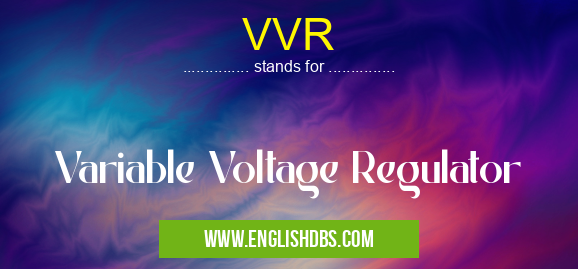What does VVR mean in UNCLASSIFIED
VVR (Variable Voltage Regulator) is an electronic device used to regulate the output voltage of a power supply to a desired level. It is commonly used in applications where a stable and adjustable voltage is required, such as powering sensitive electronic equipment or providing variable voltage for testing purposes.

VVR meaning in Unclassified in Miscellaneous
VVR mostly used in an acronym Unclassified in Category Miscellaneous that means Variable Voltage Regulator
Shorthand: VVR,
Full Form: Variable Voltage Regulator
For more information of "Variable Voltage Regulator", see the section below.
Functions
- Voltage Regulation: VVRs maintain a constant output voltage despite fluctuations in the input voltage or load current.
- Voltage Adjustment: They allow for easy adjustment of the output voltage within a specified range.
- Low Noise Operation: Many VVRs feature low noise operation, making them suitable for use in sensitive audio and scientific applications.
Types
There are different types of VVRs based on their design and functionality:
- Linear VVRs: Utilize linear components such as transistors or op-amps to regulate the output voltage.
- Switching VVRs: Employ switching power supplies to provide more efficient voltage regulation.
- Programmable VVRs: Can be controlled via digital signals to set specific output voltage levels.
Applications
VVRs are widely used in a variety of applications, including:
- Powering electronic equipment that requires a regulated voltage.
- Providing adjustable voltage for testing and calibration purposes.
- Controlling the speed of electric motors and actuators.
- Regulating voltage in battery charging systems.
Essential Questions and Answers on Variable Voltage Regulator in "MISCELLANEOUS»UNFILED"
What is a variable voltage regulator (VVR)?
A VVR is an electronic circuit that can adjust the output voltage to a desired level, typically within a specified range. It allows for dynamic control of voltage, making it suitable for various applications where voltage adjustment is required.
How does a variable voltage regulator work?
VVRs use a voltage reference, feedback loop, and control circuitry to regulate the output voltage. The feedback loop compares the output voltage to the reference voltage and adjusts the control circuitry accordingly. By manipulating the control circuitry, the VVR can increase or decrease the output voltage to match the desired level.
What are the different types of variable voltage regulators?
There are several types of VVRs, each with its own characteristics and applications:
- Linear voltage regulators use a pass transistor to control the output voltage. They offer good regulation but can be less efficient at higher power levels.
- Switching voltage regulators use a switching element, such as a MOSFET, to control the output voltage. They are more efficient than linear regulators but can introduce switching noise.
- LDO voltage regulators (low-dropout) are a type of linear regulator designed for low-voltage applications. They offer good regulation and low dropout voltage.
What are the key parameters to consider when selecting a variable voltage regulator?
When selecting a VVR, important parameters to consider include:
- Input voltage range: The range of input voltages that the VVR can accept.
- Output voltage range: The range of output voltages that the VVR can produce.
- Load current: The maximum amount of current that the VVR can supply to the load.
- Regulation: The ability of the VVR to maintain a constant output voltage despite changes in input voltage or load current.
- Efficiency: The ratio of output power to input power, indicating how much power is lost during regulation.
What are some common applications of variable voltage regulators?
VVRs are used in a wide range of applications, including:
- Power supplies: To provide adjustable voltage for powering electronic devices.
- Battery chargers: To regulate the charging voltage for batteries.
- Lighting fixtures: To dim or adjust the brightness of lights.
- Motor control: To control the speed or torque of motors.
Final Words: Variable Voltage Regulators (VVRs) are essential components in many electronic systems, providing stable and adjustable voltage regulation. Their versatility and reliability make them suitable for a wide range of applications, from powering sensitive devices to testing and calibration setups.
